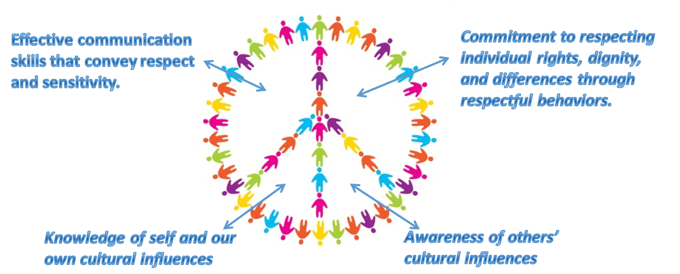Cultural training has become even more important due to today's global workforce. Learn what elements should be included to make your next cultural competency training program a success!
A single word can create the potential for misunderstanding and even conflict. That's why it can be so difficult to communicate clearly with someone else, especially someone from a different cultural background. Find out the best ways to effectively communicate with individuals from diverse backgrounds.
Download our "Effective Cultural Communication Handbook" to overcome communication differences, build bridges, and facilitate effective communication in the workplace.
Understand the Importance of Cultural Competency Training
Culture is defined as the shared values, traditions, norms, customs, and institutions of a specific group of people. A fancy definition of cultural competency is “the willingness and ability to interact respectfully and effectively with individuals and groups, acknowledging the common and different elements of our cultural identities.” The result is words and actions that recognize, affirm, and value the worth of individuals and communities as well as protect and preserve the dignity of each. “Cultural intelligence” is another term for cultural competence.
This is what cultural competence looks like:
• Becoming aware of cultural identities and how these influence the way others are treated
• Engaging each other as individuals and groups in a continuing, meaningful dialogue with the intent to establish ways to reach shared goals
• Exploring ways to tap into the full potential of all members of an organization
• Demonstrating caring and respectful behavior
• Being conscious of the dynamics inherent when cultures interact
• Respecting each person as an individual element of cultural competence
We’ve used the peace sign as a symbol of the elements of cultural competency because one of the goals of increasing cultural competence is to reduce misunderstandings and conflicts due to ignorance, and to encourage a peaceful (non-defensive and non-attacking) approach to understanding and resolving differences. The conceptual elements of knowing yourself and awareness of others are purposefully smaller than the concrete actions of communicating effectively and behaving respectfully.
Awareness of Self
The first element of cultural competence is awareness of self and one’s own culture. Here are some ways to develop that skill:
• Recognize assumptions and selective perceptions that we make about ourselves and others.
• Recognize how we categorize or put people into “slots” to make them similar or different from ourselves.
• Use context to help us interpret events and situations.
• Look at ourselves from an objective observer perspective.
• Seek out fresh information to confirm or refute our perceptions.
Identify a dimension that you have in common with others. It could be anything from being working mothers or vegetarians to political affiliations, sports, hobbies, driving the same car, etc. Sharing this dimension with others makes you an affinity group. Consider the one thing you like about being in this group and one thing you dislike about what people say regarding this group. Then, think about your own culture or heritage and consider your answers to the following questions:
• What significance does being _____________ (fill in your heritage) have for you?
• What aspects of your cultural background/s do you like?
• What aspects of your cultural background/s do you dislike?
The answers to these questions will help you to enhance your self-awareness.
Recognizing Norms and Values
Think of an interaction you had with someone from a different cultural background that left you feeling uncomfortable, or even with a negative reaction. This could be a coworker, friend, neighbor, local shop worker, etc.
Often, this may involve making a decision with another person—perhaps about where to go for lunch, which printer to use, how to start a project, etc. Perhaps the other person tried to push his/her idea on you without getting your input, or did the opposite—acquiesced to your choice without stating his/her opinion.
• What did you think about the other person’s behavior?
• In what way does his/her behavior go against, or coincide with, your own implicit cultural norms?
• What possible cultural norms may this person’s behavior demonstrate?
• How could you find out for certain?
Acknowledging Differences
One of the most common causes of misunderstanding is stereotyping others. Everyone can be stereotyped in some way, and most often there will be a higher percentage of negative characteristics. We learn stereotypes through misinformation spread by the media and other people, rumors, jokes, etc. We can “unlearn” by educating ourselves about others, accepting others’ differences, and being open-minded. If you accidentally offend someone, apologize, and pay special attention to future interactions. And if you notice someone engaging in stereotyping, don’t ignore it—diplomatically address it if possible, and certainly refuse to join in on jokes and negative comments.
Learning and applying lessons from cultural training break down stereotypes, increases understanding and promotes goodwill at your organization. Cultural differences can hamper good communication, interpersonal relationships, and more so, affect businesses which rely on multicultural clients. Many of our global operating clients ensure that their employees undergo cultural training for the success of their operations.
Learn more about cultural training from the experts at TrainingFolks


